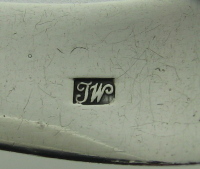Patina is a difficult
subject to discuss, however it is extremely important with antique silver
(as it is with any antique).
For those of us that watch the popular television programmes about antiques, this word is very
often used. It is most often used when discussing antique furniture,
but it also applies to silver. In the context of examining antique
silver, very often experts will say that practise and experience are the
only ways to detect a good patina. Well, whilst this may be true, it
is very easy to detect when the patina of a piece has been seriously
damaged!!
More & more often nowadays, silver dealers (and some
collectors) are polishing up their silver so much that they are actually
removing the patina. This is, of course, disastrous because it can
never be recovered. Perhaps they have the mistaken view that folks
want their silver to be extremely bright & shiny. Perhaps if you buy a
brand new piece this is what you want - you do NOT want it with an
antique. I have lifted this phrase from Wikipedia:
Apart from the aesthetic appearance and
practical protection of patination, antique experts confirm that an object's
value increases when its patination is intact because it is an important
effect of the ageing process and this evidential history is reflected in the
value of the piece.
There are all sorts
of possible technical explanations given about patina, but in its broadest
sense it is the "signs of age" that a piece has. This can be a
"dulling" of the silver or reduction in its reflective-ness but it is also
the tiny scratches and dents that a piece will receive over the years.
I have shown some
pictures below to attempt to describe the differences. To see them
properly, you will probably need to click on the pictures to zoom in.
I will update these over time, as more examples of both good and bad come to
light. Unfortunately I do not have any examples of tongs with poor
patina as I tend to try to avoid buying them! I will put pictures of
these up whenever possible.

Good Patina - notice the myriad small scratches around
this maker's mark - a true sign of 200 years' age

Good Patina - a whole pair of tongs - again notice the
myriad small scratches over the whole item (these tongs are only 120 years
old)
Patina is important. Over-polishing tongs
through use of a machine destroys the patina - and in my opinion, reduces
the value of a pair of good antique silver sugar tongs by as much as half.
I appeal to all you dealers out there -
please do not put your sugar tongs on a polishing machine.
The best way to have information about Georgian Silver
Sugar Tongs always at your finger-tips is to buy the book. It is
available from this web-site, simply click the picture!
